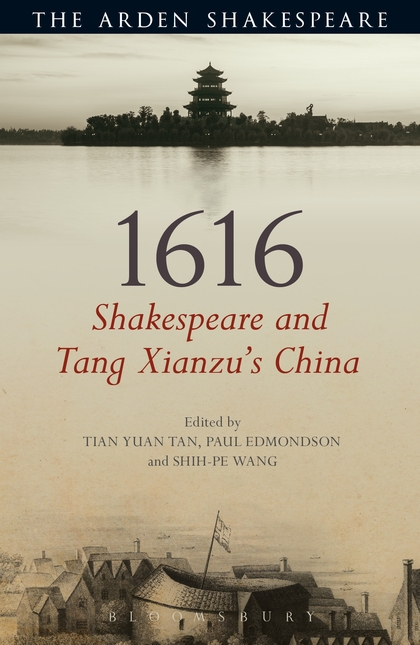China, West share legacy of great dramatic traditions

The cover of 1616: Shakespeare and Tang Xianzu’s China, which will be published on Feb. 25
2016 marks the 400th anniversary of the deaths of dramatists Tang Xianzu and William Shakespeare. During his visit to Britain in October, 2015, Chinese President Xi Jinping suggested a joint commemoration for the two masters. UNESCO will hold worldwide commemorative activities this year while academics are pondering ways to advance Sino-West comparative research on drama as well as Tang and Shakespeare.
Identical humanism
More than four centuries ago, dramas written by Tang and Shakespeare were performed in China and the UK. This was seperatively during the reign of Emperor Shenzong of the Ming Dynasty (1368-1644) in China and Elizabeth I in the UK. It was considered a golden age for drama in both China and the UK. Humanistic drama was flourishing in Britain, while China was experiencing the heyday of verse drama, said Ye Changhai, a professor from the Shanghai Theater Academy.
People are familiar with Tang’s “Four Most Renowned Dramas” and Shakespeare’s “Four Tragedies” which have been a mainstay of theater ever since they were first performed. Both Tang and Shakespeare respected humanity. They never despised the nature or desires of people. Tang advocated “blunt emotion” to counterbalance the ideas of the great classicists. Similarly, Shakespeare stood for humanism as a critique of feudalism and theocracy.
Scholars who specialize in the history of drama agree that both Tang and Shakespeare showed humanism in their works. It is not a coincidence but a product of the times.
Zhao Shanlin, a professor from East China Normal University, explained that there was an ideological trend of humanist enlightenment during the late Ming Dynasty. Tang’s dramas, The Peony Pavilion in particular, echoed the trends in the literary domain, while Shakespeare’s dramas were outcomes of the Renaissance.
Different appeal
Tang and Shakespeare both adopted a form of “poetic drama.” Unlike the tragedies and comedies of previous times, their works were built upon the strong appeal of lyrical poetry.
Using different methods, comparative studies reveal the distinct appeal of Chinese and Western dramas, like tea and coffee.
Western tragedy stresses intense conflicts, while Chinese tragedy balances miseries and sadness with descriptions of peace. Quite different from the structure of Romeo and Juliet, conflicts in The Peony Pavilion are more leisurely with meticulous stories, said Li Weimin, a professor from the Sichuan International Studies University.
As to the focus of expression, Shakespeare is a passionate “dramatic poet,” while Tang acts more like a “philosopher” with great sympathy.
Compared to Romeo and Juliet, The Peony Pavilion goes beyond humanism. The Chinese drama involves more perspectives. Li said it gives personal dignity and values an unprecedented status, representing a rebellion against Confucian ethical codes. The drama is beyond love. It conveys a philosophical reflection on society and life via the sufferings of Du Liniang, the main character. The comparison makes possible to have a better understanding of tragedies in Chinese drama, Li said.
When expressing humanity, Shakespeare adopts a more direct and diverse approach. This difference is a testament to the specific social circumstances he wrote in. The time Tang was living in coincided with the vibrancy of European commerce. It also can be interpreted as a difference between Chinese and Western traditions in which Western culture tends to be more open and Chinese culture is the other way around.
Research diversification
The works of Shakespeare were introduced to China long ago, and Tang’s works also have a long history in the West. In 1903, Lin Shu translated Tales from Shakespeare, adapted by Charles Lamb and his sister Mary, into classical Chinese. Later in 1907, Wang Guowei wrote a biography of Shakespeare.
According to Li’s research, over the past six decades, Shakespeare’s works have been adapted into 24 genres of drama in China, including modern drama, Peking Opera, Kunqu Opera, Sichuan Opera and Huangmei Opera. “This is unprecedented in Chinese adaption of foreign dramas,” Li said.
The introduction of Tang Xianzu to the Western world started later. In 1939, the earliest English version of The Peony Pavilion, translated by H. Acton, was published. In the 1990s, scholars in English-speaking countries applied Western theories and methodologies to Tang and his works. Later, Tang’s works reached the peak of their popularity after different versions of The Peony Pavilion were staged, exposing more Western audiences to Chinese drama.
Academia has diversified its comparative studies to examine the time authors lived in, their thoughts and writing achievements as well as the themes, language and characters in their works.
Li has attended many forums on Tang-Shakespeare comparative research. He said both China and Britain have made achievements by investigating their own great writers and their values from the perspective of other cultures.
Ye added that Tang’s works embody Chinese traditional culture, while Shakespeare’s dramas represent European humanist literature. “At present, studies on Tang and Shakespeare both are undergoing further self-exploitation and modernization,” Ye said.
Zhang Qingli and Li Yu are reporters at the Chinese Social Sciences Today.
